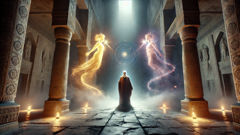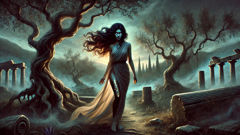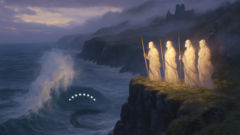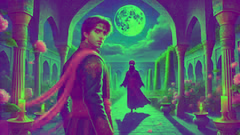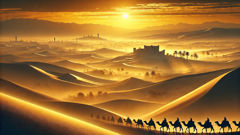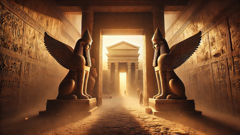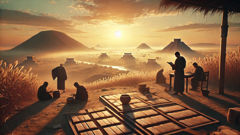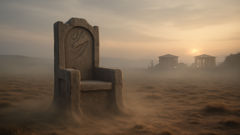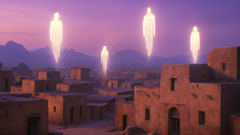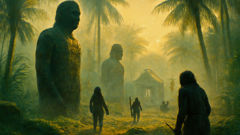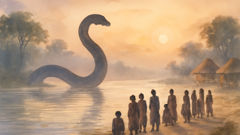Introduction
Zarvan, the primordial time-god of Zurvanite doctrine, does not stand apart from the world as a distant clockmaker. He moves within the breath of the universe, cradling the moment before birth as lovingly as the moment after. In the dim halls of a temple carved from pale limestone, priests tell of a vast loom whose threads extend into futures yet unborn. Time is not simply counted; it is braided, knotted, frayed, and redrawn. From this loom emerge two sparks, two twin spirits who will claim the heavens and the earth in a dance that will echo for centuries. The first spark is Ahura Mazda, light-bringer, guardian of order, whose voice is the pure tone of truth; the second is Angra Mainyu, shadow-sower, architect of deceit, whose whisper travels through fear, pride, and the hunger for power. The myth is not a fable about good versus evil as a tidy duel, but a conversation about what time permits and what it asks in return. It invites us to witness how a single moment can birth a choice that tilts the entire cosmos toward mercy or ruin, and how a civilization learns to read the signs. As you walk through the text, you sense the smell of burnt frankincense, the weight of basalt statues, and the quiet tremor of a people listening for the difference between the right path and the easy path. This is not merely a story from a distant land; it is a map of moral imagination, a pedagogy in narrative form, and a window into how ancient Iran set its compass toward wisdom in a world where time itself could be a god and a weapon, a mother and a debt to be repaid.
Section I — The Loom of Time and the Birth of Duality
In the earliest dawns, the sky was not empty but crowded with possibilities, a reservoir of threads waiting to be woven into the fabric of a world. Zarvan, the god who governs time without end, sat near the edge of a horizon that had not yet learned to mark its own limits. He listened to the hum of seconds as if each pulse carried a mercy or a consequence. The Zurvanite priests explained that time itself was a living agent, neither friend nor foe but a force that could cradle a universe or break it with the smallest miscount. It was in this liminal space that Zarvan forged an audacious act: to birth companions within his own breath, two halves of a singular decision, two twins who would walk the earth as the embodiments of the world’s most pressing questions. Ahura Mazda emerged with a clear, glistening radiance, a scent of resin and rain in his wake, his hands steady as a compass pointing toward a future where order would curb chaos. He spoke in measured syllables, naming the first laws that would keep despair from devouring the light. Angra Mainyu came with a wind that smelled faintly of iron and ash, a voice that teased the edges of fear and desire, asking whether the world could bear the weight of virtue without shadows to measure it by. The two spirits, born within Zarvan’s breath, did not require a parent’s kiss to claim their destinies; time itself recognized them as halves of a greater verb, a verb that would be conjugated in every epoch by every creature who would ever have to choose. The myth does not pretend that the separation was painless. It was a rupture, a tremor that traveled from the bedrock of mountains to the margins of memory, a reminder that every cosmic equilibrium rests on the willingness of beings to act—toward mercy, toward justice, toward the terrifying clarity of knowing when to stop. In the temples of ancient Iran, lay-makers carved this moment into stone—two suns rising from one sun, two voices issuing from one original breath. Priests learned to interpret the signs as a drama in which time itself is a witness, not merely a stagehand. And yet the world did not get to see the full script at once. The first chapters of our tale explore Zarvan’s introspection, his realization that to birth time’s twins is to invite a dialogue, a conversation in which yes might mean no elsewhere, and where a single act could tilt the fate of kings, farmers, poets, and thieves alike. Ahura Mazda, with a lamp of lucid light, stood at the prow of a ship sailing toward a moral arch, while Angra Mainyu, at the stern, kept the oar ready to pull the vessel toward a shore where temptation hides in the tall grasses. The audience learns to listen for what does not fit into a neat catechism: time as teacher, time as temptation, time as the ultimate judge whose verdict is not a verdict at all but a lasting invitation to choose again. The world watches with hushed reverence as the loom hums into motion, and the two spirits learn to read the fabric of reality not as a fixed map but as a living draft that requires constant revision. The birth of these twins marks a pivot in the ancient cosmology: time is not a neutral stage, but a field where the seeds of virtue and vice germinate side by side, and where every decision carries weight beyond a single lifetime. The tale invites you to sense the gravity of a moment when time itself seems to hold its breath, waiting for the people who inhabit the world to decide who they will become and what kind of cosmos they will sustain through the ages.
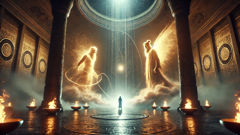
Section II — The Twin Spirits and the Shape of the World
The newborns did not descend into a world bone-dry of possibility. Instead, they arrived at a crossroads—an intersection of intention and consequence where every footstep could spiral into mercy or malevolence. Ahura Mazda learned quickly that order requires mercy to take root; that restraint is not a chain but a bridge that allows the good to stand where fear would otherwise topple it. His counsel urged cultivators of fields, judges of disputes, and stewards of the fires that lit the night—insisting that truth not be shouted but proven living by acts of care, restraint, and courage. Angra Mainyu, in contrast, tested the threshold of desire with sly laughter and the invitation of shortcuts. He asked what a harvest would become if greed measured the value of every kernel, if power corrupted even the most noble promises, and if fear could be weaponized to make obedience feel like virtue. The world, which had been listening to Zarvan’s breath and watching the loom, learned to discern the color of time through the choices its inhabitants made. Temples began to frame the cosmos not as a fixed hierarchy but as a living conversation among beings who wielded their small, fragile agency with astonishing persistence. The sages argued that time is a tutor who never retires, constantly offering new lessons in patience, restraint, and humility. In the markets, merchants kept time on counters: the hour by the chime of a bell, the day by the rising of the sun, the year by the turning of a wheel. In stories told by fires, Ahura Mazda’s name came with the aroma of cedar smoke and rain-washed stones, while Angra Mainyu’s echo traveled with the crackle of embers and the soft rustle of night winds among reeds. Yet the myth insists that duality is not simply a clash of two forces but an inseparable co-creation. Time’s twin spirits learned to look at a world that already contained the consequences of their births. They discovered that every act of mercy writes a line of light into the fabric of time, while every act of self-will cuts a thread and leaves a scar that future generations must mend or overlook. The Zurvanite cosmology emphasizes nuance: good and evil are not absolutes inhabiting distant skies, but living strains in a single universal chord, capable of harmonizing or clashing depending on the posture of those asked to decide. The chronicles recount how kings across valleys sought to align themselves with Mazda’s discipline or Angra’s restless whisper, and how poets learned to translate the tension into verses that could guide a village, a hall of guardians, or a solitary traveler toward a wiser choice. The final revelation of the section speaks to the civilization that would grow under this doctrine: a culture that understands time as a patient, inexorable tutor whose lessons emerge from the daily acts of generosity and restraint, and whose memory preserves the names of those who chose wisely when time demanded a sacrifice. It is a vision both austere and generous, a reminder that the world’s most pressing questions are not settled by force alone but by the daily acts of ordinary people who decide to offer mercy, to resist cruelty, and to accept the paradox that time itself will judge their fidelity to that vow.

Conclusion
The myth of Zarvan, Ahura Mazda, and Angra Mainyu does not end with a single verdict but with a long, quiet argument about what time makes possible. It teaches that wisdom is not a final achievement but a practice—an art of choosing when the mind would rather choose easily, when fear would prefer certainty, and when mercy demands a longer gaze. In the centuries that followed, the Zurvanite tradition offered a strange, generous portrait of the cosmos: time as a parent who teaches through trial, time as a temple’s breath that invites humility, and time as a companion who keeps faith with the future even when the present aches. The world learns to bear the tension between light and shadow because the loom of Zarvan remains in every hour’s hinge, every turning season, and every human heart that resists the easy path in favor of a path that respects other beings. The tale closes not with an era’s conquest but with a consent that lasts beyond the ages: the consent to keep time honest, to let wisdom guide courage, and to remember that the ultimate mercy is the recognition that even the gods must learn to wait for the dawn that justice requires. Thus the myth remains alive in stones and stories, in the quiet prayers of those who study ancient chronicles, and in the imagination of any reader who wonders what it means to live under time’s vast, patient gaze.

